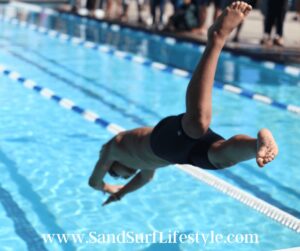Diving is a well-known sport that many participate in during school, is an internationally recognized sport, and a part of the Olympics. People jump from a springboard or platform, depending on the type of dive, into a pool of water below. Diving has similarities to other sports such as gymnastics or dance due to the flexibility and awareness required. Each dive can be categorized by a sequence of numbers ending with a letter.
Before we dive in, let’s cover the scoring systems. Before we take a deep dive into the different types and what makes each one unique there are a few things we need to cover. Such as the dive numbers used by four of the six dive groups, the systems the other two groups use, and the degree of difficulty.
Dive numbers for groups 1-4:
 Forward, back, reverse, and inwards dives are all categorized using a three-digit number system. The first digit will always be the number assigned to each dive group. This goes as follows, forward (1), back (2), reverse (3), and inward (4). This helps to distinguish which type of dive was performed when looking at the scores.
Forward, back, reverse, and inwards dives are all categorized using a three-digit number system. The first digit will always be the number assigned to each dive group. This goes as follows, forward (1), back (2), reverse (3), and inward (4). This helps to distinguish which type of dive was performed when looking at the scores.
The second digit shows if the dive was either a basic somersault, which they will receive a 0 for, or a flying dive which they will receive a 1 for. In a competition setting, you will be seeing more zero digits in the second column because flying dives are rarely done in competition.
The third digit displays how many half-revolutions the diver made during their dive. So, if a diver did an inward dive with 3 half-revolutions the display would show 403. Or if a diver did a reverse dive with five half-revolutions, their digits would display 205.
At the end of every three-digit sequence, there is a final letter that indicates what their dive position was. Options for this include a straight (A), a pike (B), a tuck (C), or a free dive (D).
A straight dive occurs when there is no bending at the hips or knees. Whereas a pike position allows a tight bend at the hips while keeping the knees straight. A tuck is when the body is curled into a ball almost, a common position for many. Lastly, a free dive occurs when the diver allows their body to change positions as they dive.
Group 5 dives:
Twisting dives fall under group five and are identified by a four-digit sequence of numbers typically. Similar to the other scoring system the first digit identifies it as a twisting dive and the second number relates to the underlying motion done in the dive. This digit relates to whether there was a forward, reverse, inward, or back position added to the dive. The third number again displays the number of half-somersaults accomplished and the fourth digit is the number of half-twists added.
Similar to the first group of dives scoring, a letter is added at the end of this sequence as well to show the dive position. An example of a dive number given could be 5246B. The 5 represents the twisting dive, the 2 shows that the underlying motion was a backward position, the 4 indicates 2 full somersaults, the 6 shows that three full twists were completed, and finally the B represents a tuck position.
Group 6 dives:
The number system for armstand dives is similar to the previous ones mentioned, however, it has its own quirk. There are actually two different systems in place depending on if the diver adds in any twists. So, we will first cover the system if twists are involved and then explain what changes if there are no twists involved.
When a twisting armstand dive occurs, there are four digits involved and the formula follows that of the twisting dives we discussed before this. So, if a twist is involved a potential score could be 6342D. The 6 represents the armstand dive, with the 3 showing a reverse position occurred, the 4 representing a double somersault took place, the 2 showing a full twist occurred, and the D meaning it all took place in a free position.
Now, if no twist takes place during the dive the sequence will only be three digits long. An example here could be a 632C. The 6 again shows that it was an armstand dive, with a reverse rotation, in a backward direction, from a tuck position.
While these scoring sequences may seem intimidating and hard to follow at times, they get easier with practice, especially if you are hoping to compete in diving competitions. Like any sport, you have to practice, practice, and practice to improve your skill and knowledge. You will know the scoring guide like the back of your hand soon.
1. Forward group:
 For the dive to be a part of this group, the diver needs to be facing forward on the springboard as they jump up. Then they will rotate their body forward as they fall to ensure that they are either feetfirst or headfirst as they hit the water. Dives in this group can be very basic or difficult depending on the number of somersaults added.
For the dive to be a part of this group, the diver needs to be facing forward on the springboard as they jump up. Then they will rotate their body forward as they fall to ensure that they are either feetfirst or headfirst as they hit the water. Dives in this group can be very basic or difficult depending on the number of somersaults added.
Examples of forward group dives are:
- Forward three and a half somersaults in a pike position (107B)
- A forward dive in a tuck position (100C)
- Forward two somersaults in a tuck position (104C)
These are just a few of the dives that can be included in the forward group. Each one is comprised of the starting position, somersaults, and a dive position.
2. Backward group:
Back dives begin with the diver standing on the tip of the board with their front facing away from the water. After the diver begins their takeoff from the board, beginning with a backward press they will rotate away from the board. As they rotate away, they can complete between half a somersault to three and a half in total.
Examples of back dives include:
- A back dive in a straight position (200A)
- Back dive with one somersault in a pike position (202B)
- Back two and a half somersaults in a tuck position (205C)
The main components of these diving numbers that change regularly are the third digit which represents the number of half-somersaults and the letter detailing the dive position. These are only a few of the types of dives that fall into the backward group category.
Find out how many types of ocean dives there are here.
3. Reverse group:
 This group of dives begins with the diver facing both the end of the board and the water before they dive. For this type of dive, a forward approach and hurdle are used as the diver moves their body backward towards the diving board while still moving forward. They can complete up to three and a half somersaults during this type of dive.
This group of dives begins with the diver facing both the end of the board and the water before they dive. For this type of dive, a forward approach and hurdle are used as the diver moves their body backward towards the diving board while still moving forward. They can complete up to three and a half somersaults during this type of dive.
Examples of reverse dives are:
- Reverse dive in a pike position (300B)
- A reverse dive with one somersault in a tuck position (302C)
- Reverse two and a half somersaults in a pike position (305B)
Reverse dives are typically performed in a pike or tuck position with varying numbers of half-somersaults taking place. While there are a few examples listed above there are still more possible dives.
4. Inward group:
Inward dives start with the diver standing on the very end of the springboard with their back placed towards the water. A backward press is used to take off from the board with the diver beginning to rotate as they move away from the board. Similar to the three previous dive groups we covered, this one can also include up to three and a half somersaults during the diver’s descent into the water.
Examples of inward dives include:
- An inward dive in an open pike position (400B)
- Inward two somersaults in a tuck position (404C)
- Inward three and a half somersaults in the pike position (407B)
The options for inward dives extend further than the examples we shared, however, these three dives in the group tend to be some of the easier ones to execute.
5. Twisting group:
Twisting dives are when things begin to switch when compared to the first four groups mentioned. Now twists are added to not only the dives but also the numbering system making it one of the more complex ones for people to understand. These dives can be completed from a forward, back, reverse, or inward position as well as an armstand. Any dive with a twist in it can technically be considered a part of the twisting group based on the definition.
 Examples of twisting dives include:
Examples of twisting dives include:
- Forward one and a half somersault, with one twist in a free position (5132D)
- Reverse one somersault, with one and a half twists in the pike position (5323B)
- Back two somersaults, two and a half twists in the free position (5245D)
When it comes to distinguishing between the different types of dives, twists begin to make the scores more advanced as well as the technique required to complete the dive.
6. Armstand group:
Armstand dives are typically completed from platforms that range from five meters to seven and a half meters, to ten meters. The diver starts this position in a handstand at the front of the platforms either facing forward with their back towards the water or backward with their front facing the water. However, this dive does not officially begin until both feet leave the platform.
Examples of armstand dives are:
- Forward armstand with one and a half somersaults in a tuck position (613C)
- Armstand reverse with two somersaults twist in the free position (6341D)
- Armstand back with half a somersault in the pike position (621B)
These are just a few examples of some basic armstand dives and their corresponding numbers.
As discussed throughout the article the six types of dives are forward, backward, reverse, inward, twisting, and armstand. Each group of dives is named after the position they begin in and the movements that follow as they jump off of their corresponding platform or board of choice. Next time you go diving you can try out a new dive if you feel comfortable doing so.
Please note: This blog post is for educational purposes only and does not constitute legal or medical advice. Please consult a legal expert or medical professional to address your specific needs.

